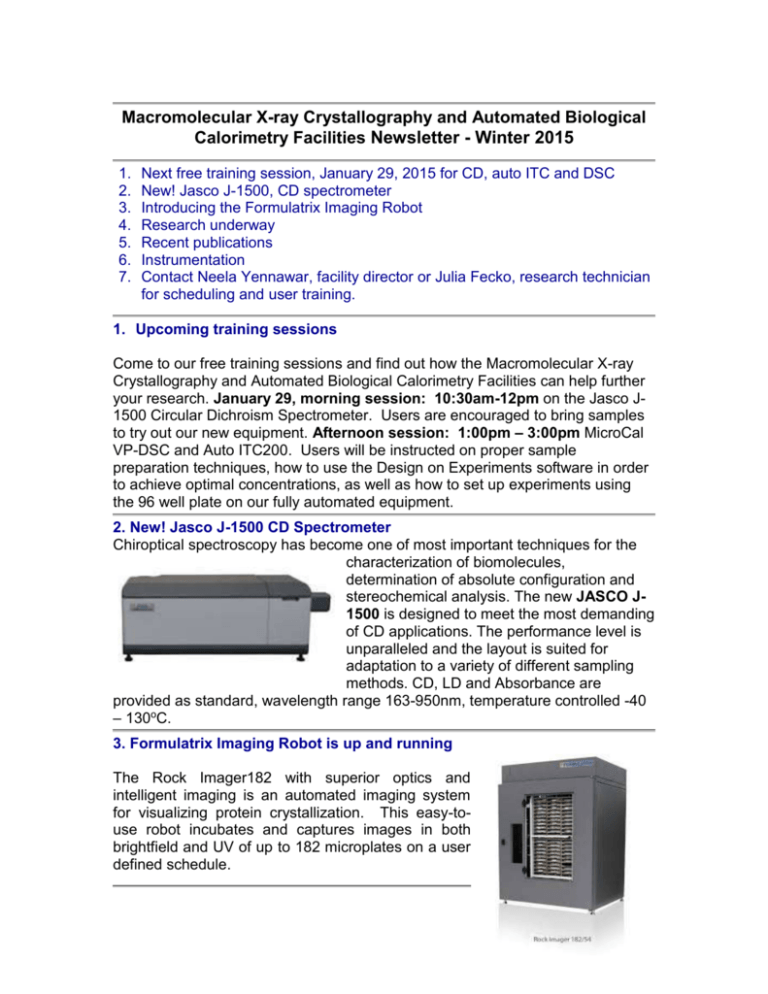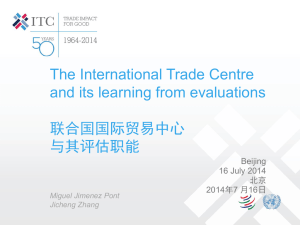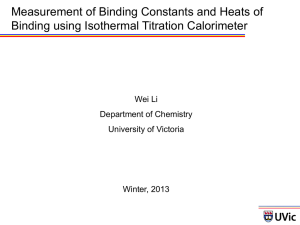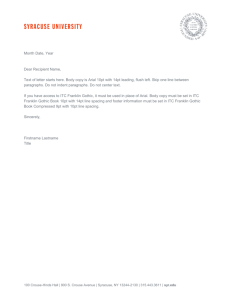Winter 2015 Newsletter
advertisement

Macromolecular X-ray Crystallography and Automated Biological Calorimetry Facilities Newsletter - Winter 2015 1. 2. 3. 4. 5. 6. 7. Next free training session, January 29, 2015 for CD, auto ITC and DSC New! Jasco J-1500, CD spectrometer Introducing the Formulatrix Imaging Robot Research underway Recent publications Instrumentation Contact Neela Yennawar, facility director or Julia Fecko, research technician for scheduling and user training. 1. Upcoming training sessions Come to our free training sessions and find out how the Macromolecular X-ray Crystallography and Automated Biological Calorimetry Facilities can help further your research. January 29, morning session: 10:30am-12pm on the Jasco J1500 Circular Dichroism Spectrometer. Users are encouraged to bring samples to try out our new equipment. Afternoon session: 1:00pm – 3:00pm MicroCal VP-DSC and Auto ITC200. Users will be instructed on proper sample preparation techniques, how to use the Design on Experiments software in order to achieve optimal concentrations, as well as how to set up experiments using the 96 well plate on our fully automated equipment. 2. New! Jasco J-1500 CD Spectrometer Chiroptical spectroscopy has become one of most important techniques for the characterization of biomolecules, determination of absolute configuration and stereochemical analysis. The new JASCO J1500 is designed to meet the most demanding of CD applications. The performance level is unparalleled and the layout is suited for adaptation to a variety of different sampling methods. CD, LD and Absorbance are provided as standard, wavelength range 163-950nm, temperature controlled -40 – 130oC. 3. Formulatrix Imaging Robot is up and running The Rock Imager182 with superior optics and intelligent imaging is an automated imaging system for visualizing protein crystallization. This easy-touse robot incubates and captures images in both brightfield and UV of up to 182 microplates on a user defined schedule. 4. Research Underway Cap VP-DSC Huihun Jung (Demirel lab, Engineering Science and Mechanics) used DSC in order to determine the stability of squid protein. Seung-Yi Lee (Cremer lab, Chemistry) used DSC to determine the stability of polycaldylacrylanide at various concentrations. Venkata Poosarla (Nixon lab, BMB) used DSC to study the folding and unfolding of cellulose. Haoshu Zhang (Harte lab, Food Science) studied how different concentrations of ethanol affect the thermal melting temperature of various proteins in cow’s milk. Chad Blamey (Fujirebio diagnostics Inc.) used DSC to test the stability of an antibody in 5 different buffer formulations while varying sucrose concentrations and pH levels. Auto-ITC Mike Gorka (Golbeck lab, BMB) used ITC to study the binding of menadione and quinone in various buffers. Al-Rizaviis (Penn State, Harrisburg) studying the thermal interaction between TS and 4 different types of amino acids using ITC Brian Kwan (Wood lab, Chemical Engineering) used auto ITC to study the binding affinity between protein Ygis and small molecule, deoxycholate. Sabina Islam (Wood lab, Chemical Engineering) is studying the binding of various metals with protein, RaIR Yan Chan (Boehr lab, Chemistry) is using auto ITC to study the binding between a peptide and 4 different types of protein. Anthony Zidell (Showalter lab, Chemistry) used ITC to study the binding between two proteins. Tayler Croom (Cameron lab, BMB) is studying the binding reaction between protein Bin1-SH3 and protein NS5A IDD as well as the full length. She is also comparing this with the binding reactions of Csrc. John McManus (Tien lab, BMB) Used auto ITC to study the interaction between protein CCpax and cellulose. Roderico Acevedo (Showalter lab, Chemistry) is using auto ITC to investigate binding between RNA and protein TRBP2 at different temperatures in order to discover what is governing the binding thermodynamically. Michael Barrera (Thomas lab, Biology) used auto ITC to study the binding between the protein spectrin alpha 0-1 with different lengths of BHx spectrin. Charlene Van Buiten (Elias lab, Food Science) used auto ITC to study the interaction between gliadin with gallic acid and catechin. Vaishnavi Chandrasekar (Anantheswaran lab, Food Science) studied the binding between nisin and chitosen as well as alginate using auto ITC. Binod Pandey (Benkovic lab, Chemistry) used auto ITC to study the binding between human PCNA and Poln. Ivan Manzano (Zydney lab, Chemical Engineering) is using auto ITC to study the binding between DNA and various amino acids. 5. Recent Publications Facility acknowledged in… 1. Spectrin tetramer formation is not required for viable development in Drosophila.KhannaMR, Mattie FJ, Browder KC, Radyk MD, Crilly SE, Bakerink KJ, Harper SL, Speicher DW, Thomas GH,(2015) J BiolChem, 290(2), 706-15. 2. Efficient Delivery of Long-Chain Fatty Aldehydes from the Nostocpunctiforme Acyl–Acyl Carrier Protein Reductase to its Cognate Aldehyde DeformylatingOxygenaseWarui, D., Pandelia, M.E., Rajakovich, L., Krebs, C., Bollinger, J.M., Booker, S., (2014) Biochemistry. doi:10.1021/bi500847u 3. Crystal structure of the PRC1 ubiquitylation module bound to the nucleosome.McGinty RK, Henrici RC, Tan S. (2014) Nature, 514(7524), 591-6 4. Thermodynamic and structural determinants of differential Pdx1 binding to elements from the insulin and IAPP promoters.Bastidas M, Showalter SA. (2013) J Mol Biol., 425(18), 3360-77 Facility co-authored 1. Reversible intermolecular e-h oxidative addition to a geometrically deformed and structurally dynamic phosphorous triamide.Zhao W, McCarthy SM, Lai TY, Yennawar HP, Radosevich AT.,(2014) J Am Chem Soc., 136(50), 17634-44. 2. 2,3-Diphenyl-1,3-thia-zolidin-4-one.Yennawar HP, Tierney J, Silverberg LJ.,(2014) ActaCrystallogr Sect E Struct Rep Online. Jul 2;70(Pt 8):o847. 3. 2,3-Diphenyl-2,3-di-hydro-4H-pyrido[3,2-e][1,3]thia-zin-4-one.Yennawar HP, Singh H, Silverberg LJ.,(2014) ActaCrystallogr Sect E Struct Rep Online. May 3;70(Pt 6):o638. 4. 2,3-Diphenyl-2,3-di-hydro-4H-1,3-benzo-thia-zin-4-one.Yennawar HP, Bendinsky RV, Coyle DJ, Cali AS, Silverberg LJ., (2014) ActaCrystallogr Sect E Struct Rep Online. Mar 22;70(Pt 4):o465. 5. 2,3-Diphenyl-2,3,5,6-tetra-hydro-4H-1,3-thia-zin-4-one.Yennawar HP, Silverberg LJ., (2014) Acta Crystallogr Sect E Struct Rep Online. Jan 15;70(Pt 2):o133. 6. Autoinhibition of the Ron receptor tyrosine kinase by the juxtamembrane domain.Wang X, Yennawar N, Hankey PA., (2014) Cell Commun Signal., doi:10.1186/1478-811X-12-28 7. Intermolecular N-H oxidative addition of ammonia, alkylamines, and arylamines to a planar σ(3)-phosphorus compound via an entropycontrolled electrophilic mechanism. McCarthy SM, Lin YC, Devarajan D, Chang JW, Yennawar HP, Rioux RM, Ess DH, Radosevich AT. (2014) J Am Chem Soc., 136(12), 4640-50. 6. Instrumentation Two walk-in crystallization chambers, Differential Scanning Calorimeter, Isothermal Titration Calorimeter, Fortebio Octet QK Biolayer interferometer, Viscotek Dynamic Light Scattering, Millipore Protein/Lipid IR Quantifier, CD spectrometer, Phoenix Crystallization Robot, Jansi UV Microscope, Formulatrix Rock Imager, Rigaku Microfocus Micromax 007 X-ray generator and Saturn 944+ CCD detector, access to Chess synchrotron for Small Angle X-Ray Scattering, Bruker powder diffractometer and Bruker small molecule X-ray diffraction system. 7. Contact us If you would like to sign up for training or instrumentation use, contact director Neela Yennawar, PhD nhy1@psu.edu 814-863-9387 or research technician, Julia Fecko jaf48@psu.edu 814-865-8068. We will be happy to schedule a training session. Look us up on our website: Automated Biological Calorimetryhttp://www.huck.psu.edu/facilities/calorimetry-up X-ray Crystallography http://www.huck.psu.edu/facilities/xray-crystallography-up





